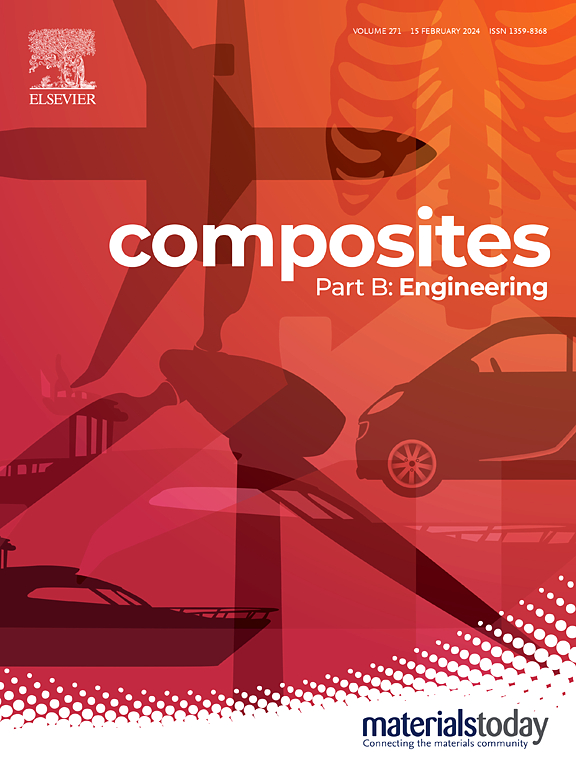Nonlinear profile engineering of 3D-printed gradient impedance structures for broadband and strong microwave absorption
IF 14.2
1区 材料科学
Q1 ENGINEERING, MULTIDISCIPLINARY
引用次数: 0
Abstract
Gradient impedance structures (GIS) are critical for broadband and strong microwave absorption, yet conventional linear geometric profiles fail to ensure optimal interlayer impedance gradients. This work introduces a novel GIS design featuring a cubic-function profile to optimize impedance matching and attenuation characteristics. Theoretical calculation and full-wave simulations reveal that concave-convex hybrid profiles enhance low-frequency attenuation while improving high-frequency impedance matching. Using 3D-printed Polyamide 12 (PA12)/Carbonyl iron powder (CIP) composite filaments, we fabricated GIS with tailored nonlinear profiles. The proposed structure achieves a broadband effective absorption bandwidth (EAB) of 14.72 GHz for reflection loss (RL) ≤ −10 dB and 9.38 GHz for RL ≤ −20 dB, with a minimum RL of −39.4 dB and a mean RL of −22.3 dB. Theoretical modeling, full-wave simulations, and experimental validation demonstrate that the cubic-function profile enables superior impedance matching and attenuation compared to conventional linear designs. This work provides a generalized framework for nonlinear profile optimization of GIS, with potential applications in aerospace and 5G electromagnetic compatibility.
三维打印宽带强微波吸收梯度阻抗结构的非线性轮廓工程
梯度阻抗结构(GIS)对于宽带和强微波吸收至关重要,但传统的线性几何剖面无法确保最佳的层间阻抗梯度。本文介绍了一种新颖的GIS设计,该设计具有三次函数剖面,以优化阻抗匹配和衰减特性。理论计算和全波仿真结果表明,凹凸混合剖面在提高高频阻抗匹配的同时增强了低频衰减。利用3d打印聚酰胺12 (PA12)/羰基铁粉(CIP)复合长丝,我们制作了具有定制非线性轮廓的GIS。当反射损耗(RL)≤−10 dB时,该结构的宽带有效吸收带宽(EAB)为14.72 GHz,当反射损耗(RL)≤−20 dB时,EAB为9.38 GHz,最小RL为−39.4 dB,平均RL为−22.3 dB。理论建模、全波仿真和实验验证表明,与传统的线性设计相比,三次函数剖面具有更好的阻抗匹配和衰减能力。该工作为GIS非线性剖面优化提供了一个通用框架,在航空航天和5G电磁兼容方面具有潜在的应用前景。
本文章由计算机程序翻译,如有差异,请以英文原文为准。
求助全文
约1分钟内获得全文
求助全文
来源期刊

Composites Part B: Engineering
工程技术-材料科学:复合
CiteScore
24.40
自引率
11.50%
发文量
784
审稿时长
21 days
期刊介绍:
Composites Part B: Engineering is a journal that publishes impactful research of high quality on composite materials. This research is supported by fundamental mechanics and materials science and engineering approaches. The targeted research can cover a wide range of length scales, ranging from nano to micro and meso, and even to the full product and structure level. The journal specifically focuses on engineering applications that involve high performance composites. These applications can range from low volume and high cost to high volume and low cost composite development.
The main goal of the journal is to provide a platform for the prompt publication of original and high quality research. The emphasis is on design, development, modeling, validation, and manufacturing of engineering details and concepts. The journal welcomes both basic research papers and proposals for review articles. Authors are encouraged to address challenges across various application areas. These areas include, but are not limited to, aerospace, automotive, and other surface transportation. The journal also covers energy-related applications, with a focus on renewable energy. Other application areas include infrastructure, off-shore and maritime projects, health care technology, and recreational products.
 求助内容:
求助内容: 应助结果提醒方式:
应助结果提醒方式:


